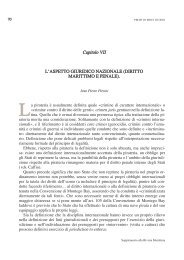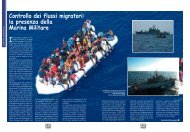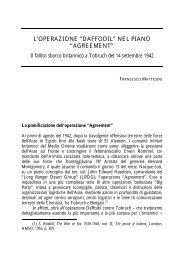143 Anno XVIII - 2008 - Marina Militare
143 Anno XVIII - 2008 - Marina Militare
143 Anno XVIII - 2008 - Marina Militare
Create successful ePaper yourself
Turn your PDF publications into a flip-book with our unique Google optimized e-Paper software.
3<br />
the first DDH, JDS Haruna (DD 141), fifty-six<br />
various surface units for a total of 48,000 tons,<br />
60 aircraft and 33 ASW helicopters. At the same<br />
time, funds were approved to implement training<br />
and education, restructuring and upgrade of<br />
facilities and bases, and improvements in<br />
communication technologies. 31<br />
The reversion of the Ryukyu Islands in 1972<br />
with the resulting widening of the maritime<br />
area to protect, the existence of a robust Soviet<br />
naval threat, and Japan’s growing dependence<br />
on imports of raw materials, reinforced the<br />
position of the navy in national defence. As<br />
the tenth JMSDF’s Chief of Maritime Staff,<br />
Admiral Samejima Hirokazu, put it, Japan<br />
lacked of primary resources and relied on<br />
imports for its own survival and as the 1973<br />
oil crisis had reminded to civilian and military<br />
authorities alike, transport at sea was vital to the<br />
archipelago’s security and to that extent, naval<br />
defence was a core part of national military<br />
capability. 32<br />
It was on the backdrop of the significance of the<br />
missions and of its expanding surface fleet that<br />
the JMSDF started devoting greater attention<br />
to its lifting capability. In particular, logistical<br />
support to land operations in Hokkaido – one<br />
of the likely areas considered for a potential<br />
Soviet invasion – coupled with the expansion of<br />
Japan’s defensive maritime perimeter, including<br />
now a considerable number of off-shore islands,<br />
KunIsaKI durante mIssIone tsunamI IndonesIa 2004<br />
demanded more adequate platforms to cover the<br />
distances within the archipelago. 33 In the context<br />
of the third and especially of the fourth build-up<br />
plans, funds were secured for the procurement<br />
of the first domestic-built tank landing ship, the<br />
1,550-ton Atsumi (LST-4101) and her two sister<br />
ships, Motobu (LST-4102) and Nemuro (LST-<br />
4103), commissioned in 1972, 1973 and 1977,<br />
respectively. 34 These units were built along<br />
with another class of three larger landing ships<br />
featuring 2,000-ton displacement, Miura (LST-<br />
4151), Ojika (LST-4152) and Satsuma (LST-<br />
4153), the last one entering service in 1977. 35<br />
With the two small 590-ton utility landing crafts<br />
of the Yura (LCU-4171) class joining the fleet<br />
in 1981, the JMSDF’s completed the core of an<br />
amphibious capability designed primarily for<br />
the purpose of defence from eventual Soviet<br />
attempts of power projection in wartime whilst<br />
critically assisting the Japanese population<br />
in case of natural disasters during peacetime.<br />
In 1976, Japanese priorities for naval defence<br />
as they had emerged early in the 1970s were<br />
formalised in the National Defence Programme<br />
Outline (NDPO) 36 and in the 1978 Guidelines for<br />
US-Japan Defence Cooperation. 37 Throughout<br />
the same period and for the rest of the Cold<br />
War, the expansion of Soviet naval power in<br />
the region led the JMSDF to reaffirm sea lanes<br />
defence as the cornerstone of its strategy, with the<br />
service focusing on a qualitative improvement<br />
of its ASW capabilities<br />
and on the extension of<br />
its range of operations up<br />
to 1,000 nautical miles. 38<br />
By contrast, the lifting<br />
capabilities the JMSDF<br />
had acquired to support<br />
efforts against territorial<br />
invasion was considered<br />
perfectly adequate to<br />
the task and remained<br />
unaltered till the end of<br />
the Cold War. In 1981, a<br />
budget request for a third<br />
unit of the Yura class was<br />
denied and reportedly no<br />
other keel for a landing<br />
unit was laid down until<br />
early in the 1990s.<br />
In the 1980s, the JMSDF’s<br />
fleet was no longer in the<br />
precarious condition of<br />
the previous decades. Its<br />
build-up now aimed at<br />
strengthening a fleet that<br />
could secure vital sea lanes<br />
and confront attempts of<br />
Soviet maritime power<br />
projection against Japan<br />
from the sea as well as on land. It is with this
















